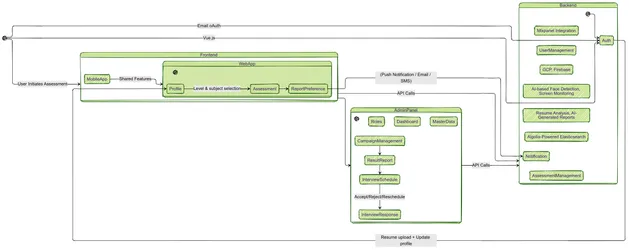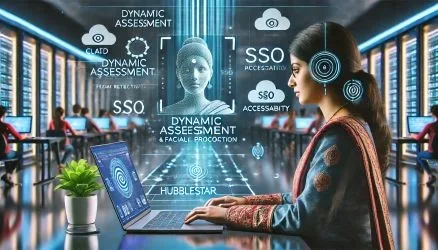Digital assessments have revolutionized the way educational institutions and corporations evaluate skills, knowledge, and competencies. From high-stakes exams to employee training programs, the shift to digital platforms has enabled faster, more efficient, and scalable evaluation processes. However, building real-time systems for digital assessments comes with its own set of challenges, especially when it comes to scalability, security, and user experience

1. Introduction
The Rise of Digital Assessments
Digital assessments have become a cornerstone of modern education and corporate training. They offer flexibility, scalability, and instant feedback, making them ideal for remote learning and distributed workforces. However, the transition from traditional pen-and-paper exams todigital platforms requires robust real-time systems that can handle high concurrency, ensure data security, and provide a seamless user experience.
The Need for Real-Time Systems
Real-time systems are critical for digital assessments to function effectively. Whether it’s live proctoring, instant result generation, or adaptive question delivery, real-time capabilities ensure that assessments are fair, secure, and efficient.
Challenges at a Glance
Building such systems is no small feat. Challenges include:
Scalability: Handling thousands of concurrent users during peak exam times.
Latency: Ensuring real-time responsiveness for proctoring and result updates.
Security: Protecting sensitive user data and preventing cheating.
Accessibility: Designing inclusive interfaces for all users.
Integration: Seamlessly combining proctoring tools, analytics platforms, and third-party APIs.
Let’s dive deeper into these challenges and explore how HubbleSTAR is solving them.
2. Core Components of a Real-Time Digital Assessment System
A robust real-time digital assessment system comprises several key components:
Frontend
User Interfaces: Intuitive dashboards for test-takers and administrators, built using Vue.js and Flutter.
Question Panels: Adaptive question panels that adjust based on user interactions.
Advanced Charts: Visualizing assessment reports and analytics using ApexCharts.
Backend
Microservices Architecture: Modular services for user management, assessment delivery, and result processing.
Database Systems: Scalable databases like Firestore (Firebase) and PostgreSQL for storing user data and assessment results.
Real-Time Communication
WebSockets: For low-latency communication between the frontend and backend.
GraphQL Subscriptions: Enabling real-time updates for dashboards and analytics.
Proctoring Tools
AI/ML Models: TensorFlow-based face detection and anomaly tracking.
Screen Monitoring: Tools like WebRTC for capturing screen activity.
Audio Analysis: Detecting suspicious sounds or conversations during exams.
Scalability and Availability
Cloud Infrastructure: Leveraging Google Cloud Platform (GCP) for elastic scaling.
Load Balancing: Distributing traffic evenly across servers to prevent downtime.

3. Challenges in Building Real-Time Systems for Digital Assessments
Scalability
Handling thousands of concurrent users during peak exam times is a major challenge. Systems must scale horizontally to accommodate sudden spikes in traffic.
Latency
Real-time proctoring and instant result updates require ultra-low latency. Any delay can compromise the integrity of the assessment.
Data Security
Protecting sensitive user data is non-negotiable. Compliance with regulations like GDPR adds another layer of complexity.
Integrity and Anti-Cheating
Developing robust proctoring solutions to prevent cheating is critical. This includes detecting impersonation, screen sharing, and unauthorized devices.
User Accessibility
Creating inclusive interfaces for users with disabilities is both a legal and ethical requirement.
Integration Complexities
Seamlessly integrating proctoring APIs, analytics platforms, and third-party tools can be daunting.
4. Solutions to Overcome These Challenges
Scalability Solutions
Cloud-Based Architecture: HubbleSTAR uses GCP to ensure elastic scaling.
Horizontal Scaling: Adding more servers during peak times to handle increased traffic.
Latency Optimization
WebSockets: For real-time communication between the frontend and backend.
Caching: Frequently accessed data is cached to reduce database load.
Security Best Practices
Secure Authentication: Single Sign-On (SSO) using Keycloak.js and OTP-based login for secure access.
Encryption: Sensitive data is encrypted both at rest and in transit.
Proctoring Innovations
AI/ML Models: HubbleSTAR uses TensorFlow for real-time face detection and anomaly tracking.
MediaPipe Integration: For advanced gesture and movement tracking.
Accessibility Enhancements
WCAG Compliance: HubbleSTAR’s UI adheres to accessibility standards.
Multi-Language Support: Ensuring inclusivity for non-native speakers.
Streamlined Integrations
Modular Architecture: HubbleSTAR’s microservices-based design allows for easy integration of third-party tools.
Role-Based Access Control (RBAC): Fine-grained access control for administrators and users.
MDM Integration: Seamless integration with the company’s central database for user management.
5. Case Study: HubbleSTAR
HubbleSTAR is a testament to how innovative technology can overcome the challenges of real-time digital assessments. Here’s how it’s making a difference:
Adaptive Algorithms: HubbleSTAR generates personalized question sets based on the test-taker’s preferences.
AI Proctoring: TensorFlow-powered proctoring tracks every movement, ensuring exam integrity.
AI-Generated Evaluations: Instant, accurate evaluations powered by AI, including
resume evaluation using OpenAI API.
Comprehensive Question Bank: A shared repository of questions used across platforms
like Hubble Vleap (LMS Platform).
Elasticsearch Powered by Algolia: Fast and efficient search capabilities for question banks and user data.
Results:
Improved scalability to handle 1,000+ concurrent users.
Reduced latency to under 200ms for real-time proctoring.
Enhanced user experience with inclusive design and multi-language support

6. Tools and Technologies
HubbleSTAR leverages cutting-edge tools and technologies:
Frontend: Vue.js, Flutter
Backend: Node.js, Firestore
Proctoring: TensorFlow, MediaPipe
Analytics: Mixpanel for user behavior tracking and insights.
SMS/Email: Gupshup for SMS notifications and SendGrid for email delivery.
Charts: ApexCharts for advanced data visualization.
Authentication: Keycloak.js for SSO, OTP based authentication for secure access
Authorization: JSON Web Token
AI/ML: OpenAI API for resume evaluation and AI-generated insights.
Search: Algolia-powered Elasticsearch for fast and scalable search functionality.
7. Best Practices for Developers
Modular Design: Build systems in reusable, independent modules.
Load Testing: Simulate high traffic to identify bottlenecks.
Security Updates: Regularly patch vulnerabilities and update dependencies.
Documentation: Maintain clear, comprehensive documentation for all integrations.
8. Future of Real-Time Digital Assessments
The future is bright for digital assessments. Trends to watch include:
AI-Driven Assessments: More personalized and adaptive testing.
Blockchain: For tamper-proof results and certificates.
Metaverse Integration: Virtual reality environments for immersive assessments.
9. Conclusion
Building real-time systems for digital assessments is a complex but rewarding endeavor. By addressing challenges like scalability, latency, and security, platforms like HubbleSTAR are setting new standards in the industry. As technology evolves, so too will the possibilities for digital assessments. We encourage innovators to explore these opportunities and push the boundaries of what’s possible.
At HubbleHox Technologies, we’re proud to lead the charge with HubbleSTAR, delivering cutting-edge solutions that redefine digital assessments.



